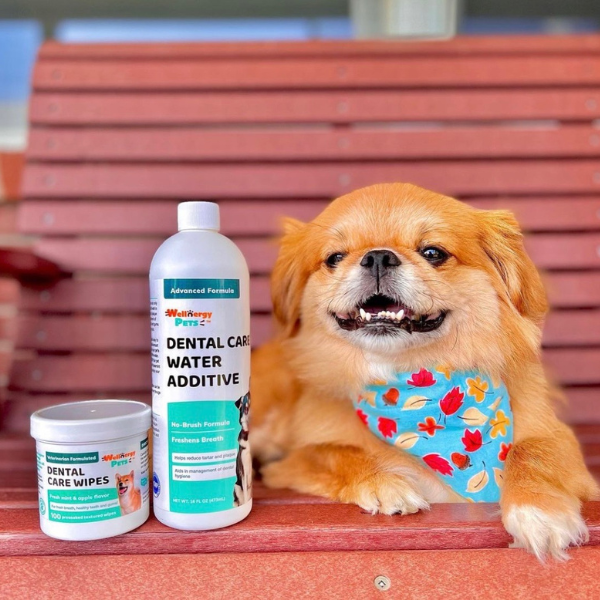For the month of February, the team at Wellnergy Pets is excited to celebrate Pet Dental Health Month. Our goal is to bring a better understanding of periodontal disease to you and quality dental care to your pets. In this blog, we will discuss the basics of periodontal disease and what can be done at home to manage its progression.
What is periodontal disease?
Periodontal disease is defined as an oral inflammatory disease affecting the periodontium that often leads to infection. It is characterized by gingivitis (inflammation of the gingiva, or gums) and dental plaque. When foreign material such as food and bacteria accumulate along the gumline, plaque begins to form, eventually creating a biofilm, which provides bacteria with the environment it needs to multiply. While a small amount of plaque is naturally removed with mastication (chewing) and tongue movements, a moderate amount is often left behind. If left untreated for too long, the plaque will begin to mineralize, causing gingivitis and bleeding of the gums. Additionally, untreated plaque leads to the development of tartar and calculus. Like a vicious cycle, the development of tartar encourages a heavier amount of plaque to stick, leading to an even greater biofilm. Over time, other structures of the oral cavity and the periodontium will suffer if not adequately taken care of.
To understand how periodontal disease harms the periodontium, it is important to understand its structures and their functions. To summarize, the periodontium is made up of 4 major components: the gingiva provides protection to the teeth and is characterized by unremarkable pocketing or sulcus depth; the cementum supports the teeth and provides a source of attachment for the alveolar bone; the alveolar bone holds down the teeth roots and absorbs pressure and forces from occlusion and mastication; the periodontal ligament attaches the teeth to the alveolar bone and protects the teeth. All of these supporting structures work together to provide stability to the teeth. The development of periodontal disease, then, disrupts that stability.

Classifications and Clinical Symptoms
Periodontal disease can be classified into 4 grades and are characterized as followed:
- Grade I: mild plaque and calculus; mild gingivitis; no evident bone loss; typically reversible with ultrasonic scaling.
- Grade II: plaque and calculus begin to spread toward the root; marked gingivitis; mild gingival pocketing and recession; mild bone loss; possible furcation exposure (the area where the tooth roots divide).
- Grade III: moderate plaque and calculus with spreading toward the root; moderate gingivitis with ulcerations; moderate gingival pocketing and recession; evident bone loss; possible furcation exposure.
- Grade IV: severe plaque and calculus; severe gingivitis with ulcerations; severe gingival pocketing and recession; severe bone and gum loss; tooth mobility.

All classifications of periodontal disease can lead to varying severities of common clinical symptoms such as halitosis (bad breath), anorexia, swelling of the face, and bleeding from the mouth, among others.
In cats, the development of a more severe oral inflammatory disease, known as stomatitis, can occur. Stomatitis is a very painful disease process that can lead to difficulty eating, and will often cause severe weight loss and unkept appearances in cats, and must be treated with dental care as soon as it is detected. Because stomatitis is many times a secondary disease to underlying systemic illnesses (such as feline calicivirus, feline immunodeficiency virus, leptospirosis, and feline panleukopenia virus, among others), it is important to consider your veterinarian’s diagnostic recommendations, which may include bloodwork and urine testing. While a dental prophylaxis is important in treating stomatitis, it is just as important to treat any underlying diseases that may be contributing to its development.
Treatment
The most basic form of treatment involves an anesthetic dental prophylaxis, which involves ultrasonic scaling and polishing, dental x-rays and probing. Depending on size, breed and lifestyle, periodontal disease may begin to develop in dogs and cats at an early age. In cats and small to medium breed dogs, for example, it is recommended to receive a full dental prophylaxis at around 1 year of age, while large breed dogs can wait to receive their first scaling until 2 years of age, followed by annual dental cleanings and regular oral health checkups.
For more severe cases, such as fractured teeth or pulp exposure that cannot be reversed with just a dental prophylactic cleaning, oral surgery may be warranted. Consult your veterinarian for options regarding surgical correction or extraction of your pet’s teeth.
Prevention
Just like in humans, dental care at home is crucial for the health of your pet. Daily mechanical brushing of your pet’s teeth is the most common method of at-home dental care. Implementing brushing in puppy- or kitten-hood is important in establishing a regular oral health routine. Start by introducing your finger or a soft cloth to the outside of your pet’s teeth, and gently move back and forth on the external surface. Once your pet is used to this, introduce pet toothpaste in a similar fashion. Eventually graduate to a toothbrush and dedicate 30 seconds of slow and gentle brushing to each side of the mouth.
Dental chews can also be used as supplementation. These are made in varying sizes depending on the size of your pet, but are typically small and can pose a choking hazard. It is important to supervise your pet at all times while giving dental chews. Frozen carrots are also a great dental treat that can be used in moderation.
A great alternative to your at-home dental care needs are the Wellnergy Pets Dental Care Wipes and Dental Care Water Additives. These products were carefully formulated by Dr. Z and are proudly endorsed by several everyday customers and well-known figures, such as Shark Tank Kevin Harrington. Simple and easy to use, our dental care wipes help fight dental disease and provide fresh breath. Our dental care water additives are just as convenient and effective; simply add to your pet’s water for productive prevention and great breath.
Design by Zonram Liao
Periodontal disease in pets is widely common, but owners often overlook the problems that it can pose if severity develops. Oral health is a crucial part of your pet’s overall health, and it is our mission to provide ease of care at the comfort of your own home and prevent the worsening of this disease. Consult with us and your veterinarian for recommendations on your pet’s at-home dental care.


